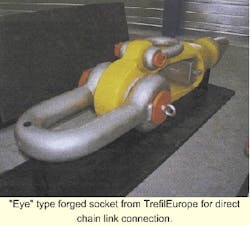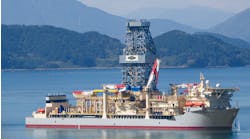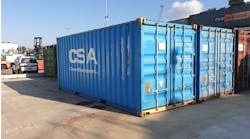Steel wire weight reduction aids deepwater mooring transition
Over the past 15 years, TrefilEurope has designed and fabricated steel wire/wire rope mooring systems for some of the world's most advanced FPSOs and Spar platforms. These include:
- Pemex's Cantarell floating production, storage, and offloading (FPSO) vessel in the Gulf of Mexico, in association with Sofec (123-mm diameter unsheathed spiral strand and forged sockets)
- Exxon Diana Spar in the US Gulf of Mexico, with Aker Rauma Offshore (143-mm diameter sheathed spiral strand with specially fabricated sockets)
- Statoil's Åsgard A FPSO (120-mm dia. sheathed spiral strand with special fabricated socket) and ÅÅsgaard B tethers (58-mm diameter sheathed spiral strand and forged sockets), both in the Nor wegian sector with Umoe Anchor Contracting
- Statoil's Heidrun DSL upgrade, in association with APL (108-mm diameter unsheathed spiral strand and forged sockets).
More recently, the company, based in Bourg en Bresse, France, has developed high tensile products in response to the industry's gravitation to ever greater depths. It has accordingly focused on reducing the size and weight of mooring systems. Steel wires have an advantage over synthetic fiber moorings, the company claims, because their behavior is well understood in terms of fatigue life, with no sensitivity to UV rays or other aging phenomena. Steel wire systems also exhibit a very low stretch characteristic (high Young's modulus), and employ well known and safe end connectors.
As for wire rope manufacture, Trefil's main achievement over the past five years has been to raise individual wire tensile strength from a basic ASTM level of 1,570 Mpa up to 1,820 Mpa - an increase of over 15% - for spiral strand applications in relatively large sizes (5.50-7.00 mm diameters). This has been made possible through the use of alloy carbon rod, via a special manufacturing process. The main advantage of the extra strength is a reduction in the spiral strand diameter, which allows the system's submerged weight to be optimized accordingly.
Coatings
In parallel, Trefil has developed its patented Corzal coating for individual wires, claimed to provide three to four times improved corrosion protection, for equal thickness, compared with standard zinc coating. Galvanization under this process attains ASTM A 856 class 100 level, with a strong iron/galfan interface between the wire and the Corzal coating. The end-result, according to Trefil, is an extension of the unsheathed spiral strand's life by three to four years.
In association with various forging groups, Trefil has also developed a socket which is available in three different shapes, to reduce the end fitting weight. Trefil has also engineered other options which include:
- The forged epoxy painted open socket, with secured pin (made from standard, duplex or superduplex steels) for connection to link, triplate or dogbone systems, or to forged closed sockets in the central areas of multiple segment mooring systems
- The forged "eye" type epoxy painted closed socket, for direct connection to the chain shackle, or open socket (as above)
- The forged "bow" type epoxy painted closed socket, for direct connection to a pile or suction anchor padeye, through connecting shackle
All these forged products are made from high strength grade 4 steel, certified up to 860 Mpa, and with DNV Type Approval. Weight is claimed to be 35-45% less than traditionally fabricated sockets. The whole end fitting shape is smooth and without sharp edges, which improves integration within the mooring system compared with conventional sockets, Trefil claims.




